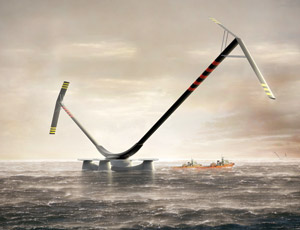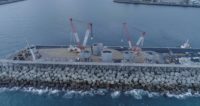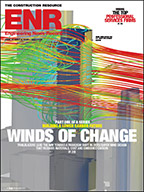Aiming to cut costs of offshore wind power, British engineers are developing a vertical-axis turbine that would eliminate the need for a tower, reduce stress on blades and foundations and ease installation work. The developer of the 10-MW device hopes to have a 1-MW proof-of-concept machine at work within two years. A full-scale demonstration would follow.

The device has two rotors attached to inclined arms. These arms rise from a vertical axle in a module sitting just above sea level on a steel jacket or other support, like a broad V-shaped sculpture on a low pedestal.
At about half the height of a conventional offshore turbine, installation of the machine, called Aerogenerator X, would be easier and safer, says Theo Bird, founder of Wind Power Ltd., Canfield, the project’s lead developer.
The turbine can produce energy regardless of wind direction, while conventional horizontal-axis machines have a narrower effective envelope. This is because its blades rotate, like a fan on its back, parallel to the wind’s direction instead of perpendicular to it. And because of a sweep radius of around 260 meters and blade arms profiled to contribute to the rotors’ generating power, the turbine could produce 10 MW, further enhancing its economic attraction, says Bird.
To minimize downtime of individual devices, “it’s likely there will be multiple generators [in each machine],” says Bird. “What we want is a very robust situation.” A number of generating equipment options have been considered in studies so far, he adds.
With some 18 months of feasibility work done, the project is moving into detailed design. Wind Power is working with various technical organizations, backed by funding from the Energy Technologies Institute, which includes the U.K. government and international corporations.
Aerogenerator X marks a major development of earlier North American work on vertical-axis turbines, says Bird. That work was stalled by structural analysis and materials deficiencies, says John Roberts, head of energy at Arup Group, London. The engineer has signed a memorandum of agreement to support the project’s design.
The end of the 1970s oil crisis also took the steam out of ongoing vertical-axis turbine development in the U.S. The lull in research opened the door for the preexisting three-blade, horizontal-axis machines that dominate the market, adds Bird.
U.S. researchers had viewed vertical-axis machines as suitable for offshore use because they “can be big, tough and easily managed,” says Bird. “Offshore is the ideal place for wind power, but is also an extremely tough environment,” he adds.













Post a comment to this article
Report Abusive Comment